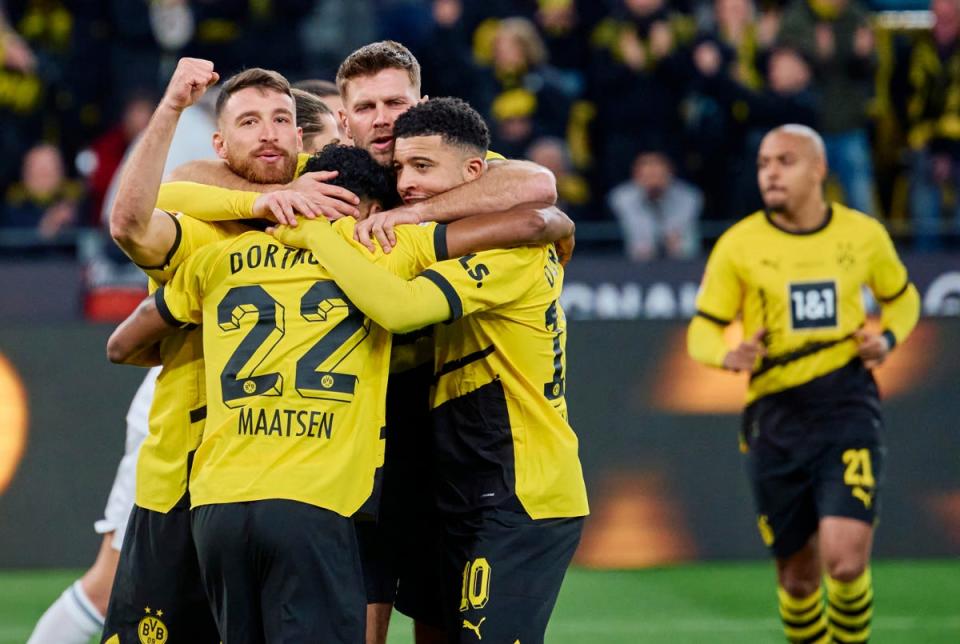The improbable inspirations behind Real Madrid and Borussia Dortmund – and why they’re back in fashion
It is only two years since Real Madrid were last in a Champions League final. Joselu was there; as a supporter, not a substitute. Then the centre-forward they faced was Sadio Mane, who finished second in the Ballon d’Or that year. Now it will be Niclas Fullkrug, who was a second-division footballer then. A fine one, admittedly; he had helped Werder Bremen to promotion but he wasn’t even their top scorer. That mantle rested with Marvin Ducksch.
Two years on, Joselu and Fullkrug are the premier centre-forwards for the Champions League finalists. In the Spaniard’s case, and as Real Madrid start without a specialist striker, it makes him Plan B. But Fullkrug could play the full game for Borussia Dortmund. Each was a semi-final hero: Fullkrug getting the first-leg winner against Paris Saint-Germain, Joselu the dramatic late brace against Bayern Munich.
There is a very real possibility that one of the unlikely lads will decide the Champions League final. And if not, maybe Euro 2024; late bloomers have assumed a role in their countries’ plans. In Fullkrug’s case, that is almost old news. The breakout stars of their otherwise demoralising 2022 World Cup were Jamal Musiala and Fullkrug: one a prodigy oozing class, long tipped for the top, the other an unglamorous centre-forward who had spent about half the previous decade in the 2. Bundesliga.
Joselu’s route has been more eclectic. He has played in three countries. Indeed, born in Stuttgart, he – like Fullkrug – has played for the latter’s hometown club. Not at the same time, however: when Hannover signed Fullkrug, Joselu was already on the books at Stoke.
If some of his fame in England stems from his time as a low-scoring centre-forward for low-scoring teams, he was a favourite of Rafa Benitez’s at Newcastle for his work rate. But, after his three-minute double against Bayern, a 2018 tweet from the journalist Mark Douglas was unearthed and enjoyed. “Joselu has just hit the corner flag with a shot from 20 yards,” he wrote.
He started to hit the back of the net more frequently after his return to Spain; in three seasons in England, he scored a total of 10 goals. In his first at Alaves, he got 11. But Joselu became more potent after his 30th birthday: his most productive two seasons are the last two, yielding 17 goals for Espanyol and then, after finally finding his way back to the club he supported, 18 on loan at Real.
Fullkrug scored 16 times for Hannover in 2017-18, but his last three seasons of his career have been the best three: the Bundesliga’s top scorer last year, Dortmund’s pragmatic signing last summer, he has struck in the Champions League quarter-final and semi-final. "It was beyond my imagination what happened in the home games against Atletico [Madrid] and Paris,” he said this week. He could complete a distinguished treble: the last player to score in quarter-final, semi-final and final in a Champions League-winning season was Cristiano Ronaldo in 2017. Should Joselu add a pair of goals in the final to his two in the semi-final, he would become the first man to do that double-double since Karim Benzema in 2018.

And he is Benzema’s unlikely replacement; simultaneously a stop-gap, a downgrade and a terrific signing who has already proved decisive and could be again. His €500,000 loan fee may prove less than Kylian Mbappe’s weekly salary but he is a brilliant bargain. At €13m, Fullkrug is dearer, but still only Dortmund’s third most expensive signing with the proceeds of Jude Bellingham’s sale.
They are symbolic figures: old-fashioned and old centre-forwards, journeymen whose journeys have largely been unspectacular, battle-hardened figures who have timed their surges to prominence.
They are the survivors of an endangered species: perhaps that is why they are so valuable now, as the other centre-forwards have died out, as footballing fashions changed and everyone seemed to want inverted wingers, false nines and fluid attackers.

Pep Guardiola’s influence spread across Spain and then, aided by his spell at Bayern Munich, Germany. Fullkrug is not a falsche neun; the strapping centre-forward who once ended up with a teammate’s tooth in his forehead can sound more like a Viking than a 21st-century footballer. Instead, he has become Dortmund’s successor to Robert Lewandowski, Pierre-Emerick Aubameyang and Erling Haaland; lacking the class of any, the high ceiling, the rise to prominence at an early age but with an eye for goal, a physical presence, a focal point in attack.
One theory as to why Joselu and Fullkrug have reached their peaks either on the brink of or in their thirties is that defenders forgot how to face the forceful centre-forward. If football is cyclical, they may prove the improbable inspirations for a revival. At the least, they have shown there is still a role for the conventional No 9. And they are advertisements for perseverance, emblematic everymen who show that players who never looked destined for greatness may still acquire it. As it transpired, they could go far beyond the bottom half of the Bundesliga. If they thought it was all Hannover, it really isn’t now.


 Yahoo Sport
Yahoo Sport 



































































